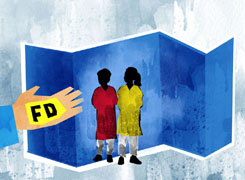
I am Swapnil Joshi. Age 43. I am working in Ad agency in Mumbai. I am from Mumbai.I own a house on Ghodbunder Road which is rented out at 15000 per month. Monthly maintenance 3700. My income is gross 12 lacs per annum. I have approx 1 cr Mutual fund portfolio with 52500 sip. 2500 cash sip and 50000 swp, via existing, funds in portfolio. I have few FD, around 3 to 4 lacs. Around 7 lacs in liquid fund, which is used as pledge for option trading. It gives me around 5.5% growth and also around 1500 to 2000 per month via options income. I have LIC policy, which will get matured by next 5 years. It will give me around 15 lacs as final sum assured. My monthly expense is around 50000. I had booked a home at Pune in 2015, but builder is in jail. Loan is on my and my wife's name. Loan is of 20 lacs but money paid to builder is 12 lacs. Since last 8 years work has stopped. So interest liability including principle for Loan is around 16 lacs by now. I have not paid any EMI yet as property is in dispute, but my cibil is affected due to the outstanding loan on my name.
I am married and I have a son, who is in 8th standard. My wife is working as freelance with monthly income around 35000. Currently I am staying with my father. My current stay is owned by my father and eventually it will be owned by me. I have elder brother who is in US as a citizen. He owns his own house in nearby vicinity near me.
I want to know, how much funds I need to have to maintain my life style when i am around 50 years of age and suggestions u would give to have better income via existing income.
Ans: Current Financial Situation and Analysis
Mr. Swapnil, thank you for sharing your detailed financial background. Your current situation includes a variety of assets and income streams, giving you a stable base. However, there are some areas where strategic adjustments could improve your financial health and future security.
Let's break down your financial picture:
Monthly Income: You earn Rs 1 lakh per month. Your wife contributes Rs 35,000 per month. Together, your total gross monthly income is Rs 1.35 lakh.
Mutual Funds: You have a Rs 1 crore mutual fund portfolio, with a Rs 52,500 monthly SIP, Rs 2,500 cash SIP, and a Rs 50,000 SWP.
Fixed Deposits: You have Rs 3-4 lakhs in fixed deposits.
Liquid Fund: You hold Rs 7 lakhs in a liquid fund, used as collateral for option trading. It yields 5.5% and around Rs 1,500-2,000 monthly from options trading.
Real Estate: You own a house on Ghodbunder Road, which is rented out at Rs 15,000 per month. After maintenance, you net Rs 11,300.
Loan Situation: You have an unresolved loan issue related to a property in Pune, with a total outstanding liability of Rs 16 lakhs. This affects your CIBIL score.
Insurance: You hold an LIC policy maturing in five years, with a final sum assured of Rs 15 lakhs.
Family: You are married with a son in the 8th standard, and you reside in your father's house, which will eventually be yours. You also have an elder brother living nearby in his own home.
Expenses: Your monthly expenses are around Rs 50,000.
Evaluating Your Income and Expenses
Your current income is sufficient to cover your expenses, but your savings and investment patterns need some fine-tuning to ensure long-term financial stability.
Mutual Fund Portfolio: Your Rs 1 crore mutual fund portfolio is a strong asset. However, you might want to reassess the funds you are invested in, especially if some are underperforming. Actively managed funds, especially those curated by a Certified Financial Planner, can often outperform passive funds in the long run, especially in the Indian market where the dynamics can be more volatile.
SWP Strategy: The Rs 50,000 SWP is a good way to generate a steady income. But be cautious; withdrawing too much can deplete your corpus faster than anticipated, especially if market conditions are unfavorable. Consider reducing the SWP or ensuring that the funds you withdraw are from low-risk or conservative growth funds to protect your capital.
Fixed Deposits and Liquid Funds: Your FDs and liquid funds offer safety but limited growth. Given your risk tolerance and financial goals, you might want to reallocate some of these funds into higher-yielding debt instruments or even conservative mutual funds. The liquid fund used for option trading is a smart strategy for liquidity and income, but the returns are modest. You could explore other low-risk options that provide better returns without locking your money away.
Real Estate Rental Income: The rental income from your Ghodbunder Road property contributes Rs 11,300 per month after maintenance. While this is stable, it might not keep pace with inflation over time. Consider reviewing the rent periodically to ensure it remains competitive with market rates. Also, factor in potential property tax increases or additional maintenance costs in your future planning.
Addressing the Loan Issue
The unresolved loan related to the Pune property is a significant concern, especially as it affects your CIBIL score. A poor CIBIL score can limit your access to credit in the future and lead to higher interest rates.
Action Steps:
Legal Consultation: Consider consulting a property lawyer to explore legal options for resolving this dispute. Your goal should be to minimize further financial damage and possibly recover some of your initial investment.
Debt Resolution: If possible, negotiate with the lender to settle the outstanding loan. This could involve paying off the loan at a negotiated amount to clear your name from the dispute.
Future Planning: Income at Age 50
You’ve asked how much you’ll need to maintain your lifestyle when you’re 50. Here’s a broad framework:
Current Lifestyle: Your monthly expenses are Rs 50,000. Assuming a moderate inflation rate of 6%, your monthly expenses could double by the time you turn 50. You may need around Rs 1 lakh per month to maintain your current lifestyle.
Target Corpus: To generate Rs 1 lakh per month, you’ll need a retirement corpus that can provide this income without depleting your principal. Based on conservative estimates, you might require a corpus of around Rs 2-2.5 crores by the time you turn 50. This assumes a mix of safe investments with moderate returns.
Recommendations for a Better Income Stream
To improve your income streams and ensure long-term financial security, consider the following strategies:
Increase SIP Contributions: If possible, gradually increase your SIP contributions. Regularly review and rebalance your portfolio with the help of a Certified Financial Planner. They can help you optimize your returns by investing in funds that align with your risk tolerance and financial goals.
Review Insurance Policy: Your LIC policy will mature in five years, giving you Rs 15 lakhs. Consider whether this amount could be better utilized in a diversified investment portfolio. If the returns from the policy are low, it might be wise to surrender and reinvest the proceeds.
Explore Debt Mutual Funds: Since you have some fixed deposits, consider moving a portion into debt mutual funds. They typically offer better returns than FDs while maintaining a similar risk profile. This could be a good way to boost your income while keeping your capital relatively safe.
Reduce SWP if Necessary: If you’re relying heavily on your SWP, it may be wise to reduce withdrawals slightly to preserve your corpus. Consult with a Certified Financial Planner to adjust your SWP based on your portfolio’s performance.
Plan for Your Son’s Education: Given your son’s age, you should start planning for his higher education expenses. Begin by estimating the costs and then setting aside a specific portion of your investments towards this goal. Education inflation is high, and it’s crucial to have a dedicated fund.
Enhance Your Wife’s Income: If your wife’s freelance income is consistent, consider setting up a systematic investment plan (SIP) in her name. This not only helps with wealth accumulation but also provides her with financial security.
Final Insights
Mr. Swapnil, your financial journey is on the right track, but some strategic adjustments are needed. Focus on optimizing your current investments, resolving your loan issue, and planning for future expenses like your son’s education and your retirement. By doing so, you’ll be well-prepared to maintain your lifestyle at age 50 and beyond.
Best Regards,
K. Ramalingam, MBA, CFP,
Chief Financial Planner,
www.holisticinvestment.in

























